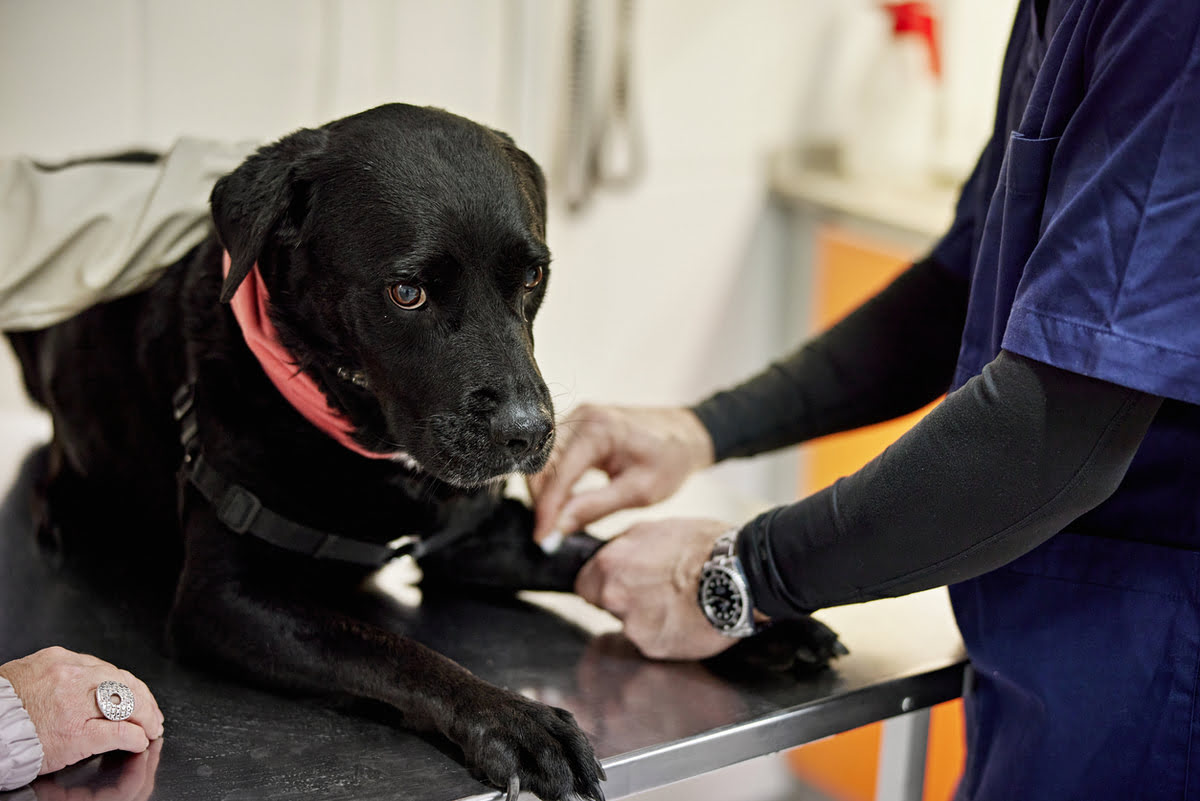Home>Health & Wellness>Common Health Issues>Heart Health>How Long Will A Dog Live With Heartworm?


Heart Health
How Long Will A Dog Live With Heartworm?
Published: February 7, 2024
Learn about heart health in dogs and how heartworm can impact their lifespan. Discover the factors that affect a dog's longevity with heartworm and how to protect their heart health.
(Many of the links in this article redirect to a specific reviewed product. Your purchase of these products through affiliate links helps to generate commission for Pawsomeoldies.com, at no extra cost. Learn more)
Table of Contents
Introduction
Heartworm disease is a serious and potentially fatal condition that can affect dogs of all breeds and ages. It is caused by the parasitic worm Dirofilaria immitis, which is transmitted through the bite of an infected mosquito. Once inside a dog's body, these worms can grow and multiply, leading to severe damage to the heart, lungs, and blood vessels.
Understanding the impact of heartworm disease is crucial for every dog owner. While prevention is the best approach, early detection and appropriate treatment are essential for the well-being of our beloved canine companions. By delving into the details of heartworm disease, its symptoms, treatment options, and preventive measures, we can equip ourselves with the knowledge needed to safeguard our furry friends from this potentially devastating illness.
As we explore the intricacies of heartworm disease, it's important to recognize the significance of proactive care and regular veterinary check-ups. By staying informed and vigilant, we can take proactive steps to protect our canine companions and ensure their long-term health and happiness.
Read more: How Long Can A Dog Live With Skin Cancer
Understanding Heartworm Disease
Heartworm disease is a potentially life-threatening condition that primarily affects dogs but can also occur in other animals, including cats and ferrets. It is caused by the parasitic worm Dirofilaria immitis, which is transmitted through the bite of an infected mosquito. When an infected mosquito bites a dog, it deposits microscopic heartworm larvae onto the skin, which then enter the dog's body through the mosquito's bite wound. Over the course of several months, these larvae mature and migrate through the dog's body, eventually reaching the heart and pulmonary arteries.
Once in the heart and blood vessels, the adult heartworms can cause severe damage and inflammation, leading to a range of health issues. The presence of these worms can obstruct blood flow, leading to increased pressure within the pulmonary arteries and the right side of the heart. This can result in heart failure, lung disease, and other serious complications.
The severity of heartworm disease can vary depending on factors such as the number of worms present, the duration of the infection, and the dog's immune response. In some cases, dogs may show relatively mild symptoms or even remain asymptomatic, especially in the early stages of the disease. However, as the infection progresses and the number of worms increases, the impact on the dog's health becomes more pronounced.
Understanding the life cycle of the heartworm and the potential consequences of the disease is crucial for pet owners. By recognizing the transmission process and the internal damage caused by the presence of these parasites, dog owners can appreciate the importance of preventive measures and regular screenings. Through this understanding, we can take proactive steps to protect our furry companions from the devastating effects of heartworm disease.
Symptoms of Heartworm Disease in Dogs
Recognizing the symptoms of heartworm disease in dogs is crucial for early detection and prompt intervention. While the progression of the disease can vary, understanding the potential signs and symptoms can help dog owners seek timely veterinary care and support their pet's well-being.
-
Coughing: Persistent coughing, especially after exercise or during periods of physical exertion, can be a common early sign of heartworm disease in dogs. The presence of heartworms in the pulmonary arteries can lead to irritation and inflammation, triggering bouts of coughing as the body attempts to clear the airways.
-
Exercise Intolerance: Dogs with heartworm disease may exhibit reduced tolerance for physical activity. They may become fatigued more quickly during walks or playtime, showing signs of lethargy or reluctance to engage in activities they previously enjoyed.
-
Respiratory Distress: As the disease progresses, dogs may experience difficulty breathing or exhibit labored breathing, especially during exertion or when resting. This can be indicative of significant lung and heart involvement due to the presence of heartworms.
-
Reduced Appetite and Weight Loss: Dogs affected by heartworm disease may show a decreased interest in food, leading to a decline in appetite and subsequent weight loss. This can be a result of the overall impact of the disease on the dog's health and well-being.
-
Enlarged Abdomen: In advanced cases, dogs may develop an enlarged abdomen due to the accumulation of fluid in the abdominal cavity, a condition known as ascites. This can be a consequence of heart failure and impaired circulation caused by the presence of heartworms.
-
Lethargy and Weakness: Dogs with heartworm disease may exhibit general lethargy, weakness, and a reduced interest in physical activities. This can be attributed to the strain on the cardiovascular system and the overall impact of the disease on the dog's energy levels.
-
Fainting or Collapse: In severe cases, dogs may experience episodes of fainting or collapse, often triggered by physical exertion or excitement. These episodes can be alarming and indicate advanced stages of heartworm disease.
It's important to note that the severity and combination of symptoms can vary among affected dogs. Additionally, some dogs may show minimal or subtle signs of heartworm disease, especially in the early stages. Regular veterinary check-ups and heartworm screenings are essential for early detection and effective management of the disease.
By recognizing these potential symptoms and seeking prompt veterinary care, dog owners can play a pivotal role in supporting their pet's health and well-being in the face of heartworm disease.
Treatment Options for Heartworm Disease
The treatment of heartworm disease in dogs is a complex and multi-faceted process that requires careful management and veterinary expertise. While prevention remains the cornerstone of addressing heartworm disease, dogs that have already been infected require specific treatment protocols to mitigate the impact of the disease and improve their long-term prognosis.
The primary goal of heartworm treatment is to eliminate the adult worms from the dog's body and address any associated complications. It's important to note that the treatment process can be challenging and carries certain risks, especially in cases where the disease has progressed to advanced stages. The treatment approach typically involves the following key components:
-
Stabilization: Before initiating specific heartworm treatment, it is crucial to stabilize the dog's condition, especially if the disease has led to severe complications such as heart failure or respiratory distress. This may involve medications to manage symptoms and support the dog's cardiovascular and respiratory function.
-
Adulticide Therapy: The next phase of treatment involves the administration of adulticide medications designed to kill the adult heartworms residing in the dog's heart and pulmonary arteries. These medications are typically administered in a series of injections under the supervision of a veterinarian. The process requires close monitoring due to the potential for adverse reactions as the worms begin to die and break apart within the blood vessels.
-
Anti-Inflammatory and Supportive Care: In addition to adulticide therapy, dogs undergoing heartworm treatment may receive anti-inflammatory medications to address the inflammatory response triggered by the presence of the worms. Supportive care, including rest, restricted activity, and a tailored diet, may also be recommended to aid the dog's recovery and minimize stress on the cardiovascular system.
-
Post-Treatment Monitoring: Following adulticide therapy, dogs will require careful monitoring to assess their response to treatment and detect any potential complications. This may involve follow-up visits to the veterinarian, as well as diagnostic tests to evaluate the dog's heart and lung function.
It's important to emphasize that heartworm treatment is not without risks, and the potential for complications exists, particularly in cases of advanced disease. Additionally, the cost of treatment and the commitment required from dog owners in terms of post-treatment care and monitoring should be carefully considered.
By understanding the intricacies of heartworm treatment and collaborating closely with veterinary professionals, dog owners can navigate the challenges associated with heartworm disease and provide their canine companions with the best possible care and support throughout the treatment process.
Prognosis and Life Expectancy for Dogs with Heartworm Disease
The prognosis and life expectancy for dogs diagnosed with heartworm disease are influenced by various factors, including the stage of the disease, the presence of complications, the dog's overall health, and the effectiveness of the treatment provided. Understanding the potential outcomes and long-term implications of heartworm disease is essential for dog owners and veterinarians as they navigate the complexities of managing this condition.
In cases where heartworm disease is detected in its early stages, before significant damage has occurred, the prognosis can be more favorable. With timely intervention and appropriate treatment, dogs may have a higher likelihood of recovery and a relatively normal life expectancy. However, even in these instances, the treatment process can be demanding, requiring careful monitoring and post-treatment care to ensure the best possible outcome.
In more advanced cases, where the disease has progressed and led to complications such as heart failure, pulmonary hypertension, or severe lung disease, the prognosis may be guarded. The presence of a large number of adult heartworms can exert substantial strain on the dog's cardiovascular and respiratory systems, impacting their overall well-being and longevity. In such situations, the prognosis is influenced by the dog's response to treatment, the presence of concurrent health issues, and the degree of irreversible damage caused by the disease.
It's important to acknowledge that while treatment can effectively eliminate adult heartworms from the dog's body, the residual effects of the disease and the potential for long-term complications may impact the dog's quality of life and life expectancy. Even after successful treatment, some dogs may experience lasting effects on their heart and lungs, necessitating ongoing management and monitoring to support their health and well-being.
The commitment of dog owners to adhere to post-treatment care recommendations, including restricted activity, medication administration, and regular veterinary check-ups, plays a crucial role in shaping the long-term prognosis for dogs with heartworm disease. By following the guidance of veterinary professionals and providing attentive care, dog owners can contribute to their pet's recovery and overall prognosis.
Ultimately, the prognosis and life expectancy for dogs with heartworm disease are influenced by a combination of factors, including the stage of the disease, the dog's response to treatment, and the ongoing management of potential complications. By remaining vigilant and proactive, dog owners can strive to optimize the well-being and longevity of their beloved canine companions in the face of this challenging condition.
Read more: How Long Does A Dog Live With Cancer
Preventing Heartworm Disease in Dogs
Preventing heartworm disease in dogs is a fundamental aspect of responsible pet ownership and plays a pivotal role in safeguarding the health and well-being of our canine companions. By implementing proactive measures and adhering to preventive strategies, dog owners can significantly reduce the risk of their pets contracting this potentially devastating illness.
1. Administration of Preventive Medications
Regular administration of veterinarian-prescribed heartworm preventive medications is a cornerstone of effective disease prevention. These medications are available in various forms, including chewable tablets, topical solutions, and injectable formulations. By following the prescribed dosing schedule and ensuring consistent use of preventive medications, dog owners can create a protective barrier against heartworm infection.
2. Year-Round Protection
Maintaining year-round protection against heartworm disease is essential, regardless of geographical location or seasonal variations. Mosquitoes, the primary vectors for heartworm transmission, can thrive in diverse environments, making continuous preventive measures crucial for comprehensive disease control. By prioritizing year-round protection, dog owners can mitigate the risk of heartworm transmission and provide continuous defense for their pets.
3. Regular Veterinary Check-Ups
Scheduling routine veterinary check-ups is integral to comprehensive heartworm prevention. During these visits, veterinarians can conduct heartworm screenings and assess the overall health of the dog. Early detection of heartworm infection enables prompt intervention and treatment, preventing the progression of the disease and minimizing potential complications.
Read more: How Long Will A Tick Live On A Dog
4. Environmental Management
Implementing environmental management strategies to reduce mosquito exposure can complement preventive medications and enhance overall disease prevention. Measures such as eliminating standing water, using mosquito repellents in outdoor spaces, and minimizing outdoor activities during peak mosquito activity hours can contribute to reducing the risk of heartworm transmission.
5. Education and Awareness
Educating dog owners about the significance of heartworm disease prevention and raising awareness about the importance of regular preventive measures are essential components of comprehensive disease control. By fostering understanding and promoting proactive care practices, dog owners can actively contribute to the collective effort to prevent heartworm disease in canine companions.
By integrating these preventive strategies into their pet care routines, dog owners can create a protective shield against heartworm disease, ensuring the long-term health and well-being of their beloved canine companions. Through a combination of preventive medications, regular veterinary oversight, environmental management, and education, dog owners can play a pivotal role in mitigating the impact of heartworm disease and fostering a thriving, heartworm-free environment for their pets.
Conclusion
In conclusion, the impact of heartworm disease on dogs is a significant concern for pet owners and veterinarians alike. The intricate interplay between the parasitic infection, its potential complications, and the long-term prognosis underscores the importance of proactive care and preventive measures. By understanding the complexities of heartworm disease and its implications for canine health, dog owners can take informed steps to protect their beloved pets from this potentially devastating condition.
The recognition of symptoms such as coughing, exercise intolerance, and respiratory distress serves as a crucial foundation for early detection and intervention. Timely veterinary care and heartworm screenings play a pivotal role in identifying the presence of the disease and initiating appropriate treatment protocols. Additionally, the commitment to year-round preventive medications, regular veterinary check-ups, and environmental management can collectively fortify the defense against heartworm transmission, creating a shield of protection for dogs.
The treatment of heartworm disease demands careful consideration and close collaboration with veterinary professionals. From stabilization and adulticide therapy to post-treatment monitoring, the journey of addressing heartworm disease requires dedication and vigilance. While the prognosis for dogs with heartworm disease can vary based on individual circumstances, the commitment to post-treatment care and ongoing management is instrumental in shaping the long-term well-being of affected pets.
Ultimately, the prevention of heartworm disease stands as a cornerstone of responsible pet ownership. By integrating preventive strategies into their pet care routines and fostering awareness within their communities, dog owners can contribute to a collective effort to create a heartworm-free environment for their beloved companions. Through education, proactive care practices, and a steadfast commitment to preventive measures, dog owners can champion the well-being and longevity of their canine companions in the face of heartworm disease.
As we navigate the complexities of heartworm disease, let us remain steadfast in our dedication to the health and happiness of our furry friends. By staying informed, proactive, and compassionate, we can create a supportive environment that safeguards our dogs from the perils of heartworm disease, ensuring that they thrive in a world free from this formidable threat.
In the end, our commitment to the well-being of our canine companions serves as a testament to the enduring bond between humans and dogs, reflecting our unwavering dedication to their health and happiness.













